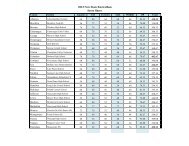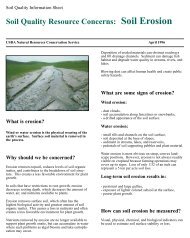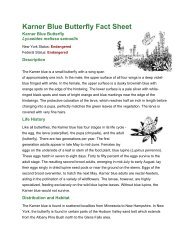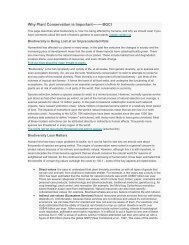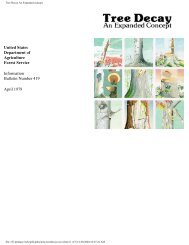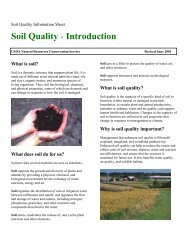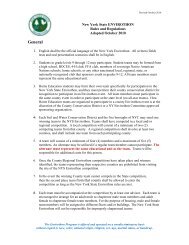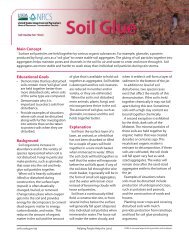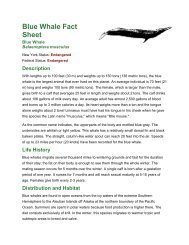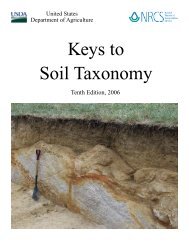Guidelines for Soil Quality Assessment in Conservation Planning
Guidelines for Soil Quality Assessment in Conservation Planning
Guidelines for Soil Quality Assessment in Conservation Planning
Create successful ePaper yourself
Turn your PDF publications into a flip-book with our unique Google optimized e-Paper software.
4. ANALYZE RESOURCE DATA—EVALUATING AND<br />
INTEGRATING RESULTS<br />
LOOK FOR PATTERNS<br />
Group test results from similar <strong>in</strong>dicators<br />
and look <strong>for</strong> patterns. For example, does<br />
one field consistently have poor<br />
<strong>in</strong>filtration and dra<strong>in</strong>age? Does another<br />
field show a large quantity of soil life,<br />
and have good residue decomposition<br />
and a desired smell? Do the crops <strong>in</strong><br />
another field show a healthy stand, good<br />
vertical roots, and consistent color?<br />
Each set of results may show an<br />
emerg<strong>in</strong>g trend <strong>in</strong> a particular field<br />
toward some level of soil quality.<br />
COMPARE RESULTS<br />
If different methods have been used, an<br />
ideal set of results would show<br />
<strong>in</strong>dicators with similar trends. For<br />
example, the <strong>Soil</strong> Health Card would<br />
show excellent tilth <strong>in</strong> the same field that<br />
had higher organic matter percent values<br />
reported from the lab tests. Or, both the<br />
<strong>Soil</strong> <strong>Quality</strong> Test Kit and lab tests would<br />
show higher bulk density <strong>in</strong> a field<br />
which the Health Card has shown to<br />
have an obvious hard pan or stunted<br />
roots. Aga<strong>in</strong>, these results suggest a<br />
trend toward a particular level of soil<br />
quality.<br />
EVALUATE DISCREPANCIES<br />
Interpretation of results is more<br />
complicated if similar <strong>in</strong>dicators show<br />
differ<strong>in</strong>g trends from similar<br />
measurements or from different<br />
methodologies. For example, a visual<br />
observation might <strong>in</strong>dicate stunted and<br />
horizontal roots, but the <strong>Soil</strong> <strong>Quality</strong><br />
Test Kit may show that water <strong>in</strong>filtration<br />
and bulk density are adequate. In this<br />
scenario, consider all the possible<br />
reasons <strong>for</strong> the root problems such as<br />
pathogen <strong>in</strong>festation, nutrient deficiency,<br />
or element toxicity (alum<strong>in</strong>um). In<br />
particular, if plants are part of the<br />
assessment, be sure to look beyond soil<br />
characteristics to possibilities such as<br />
disease or nutrient problems.<br />
The <strong>Soil</strong> <strong>Quality</strong> Test Kit Guide is a<br />
good source <strong>for</strong> background <strong>in</strong><strong>for</strong>mation<br />
and <strong>in</strong>terpretation of results. For each<br />
<strong>in</strong>dicator <strong>in</strong> the kit, the guide has an<br />
<strong>in</strong>terpretation section with <strong>in</strong><strong>for</strong>mation<br />
<strong>for</strong> evaluat<strong>in</strong>g results and improv<strong>in</strong>g soil<br />
quality. Although the <strong>Soil</strong> <strong>Quality</strong> Test<br />
Kit Guide is written to support the<br />
<strong>in</strong>dicators <strong>in</strong> the <strong>Soil</strong> <strong>Quality</strong> Test Kit,<br />
the <strong>in</strong>terpretation section is useful <strong>for</strong><br />
results from either the health cards or<br />
NRCS Template, s<strong>in</strong>ce the <strong>in</strong>dicators are<br />
often the same.<br />
Interpretive <strong>in</strong><strong>for</strong>mation from soil test<strong>in</strong>g<br />
labs is not very comprehensive, but the<br />
labs do usually send useful target ranges<br />
and recommendations <strong>for</strong> certa<strong>in</strong> fertility<br />
and chemical measurements.<br />
When a discrepancy occurs, carefully<br />
review the sampl<strong>in</strong>g procedure and<br />
analysis. Be sure to check that all<br />
samples were collected at the same time<br />
and under similar conditions such as<br />
location, moisture, and pre- or posttillage.<br />
Ensure that procedures were<br />
followed very carefully <strong>for</strong> the test kit<br />
and lab analysis. For example, if lab<br />
samples <strong>for</strong> bulk density were collected<br />
from with<strong>in</strong> the crop row and test kit<br />
samples were collected from between<br />
the crop rows or <strong>in</strong> the wheel track, the<br />
same “sites” were not sampled and<br />
would not be expected to be similar. Be<br />
sure that any numerical results have been<br />
17




